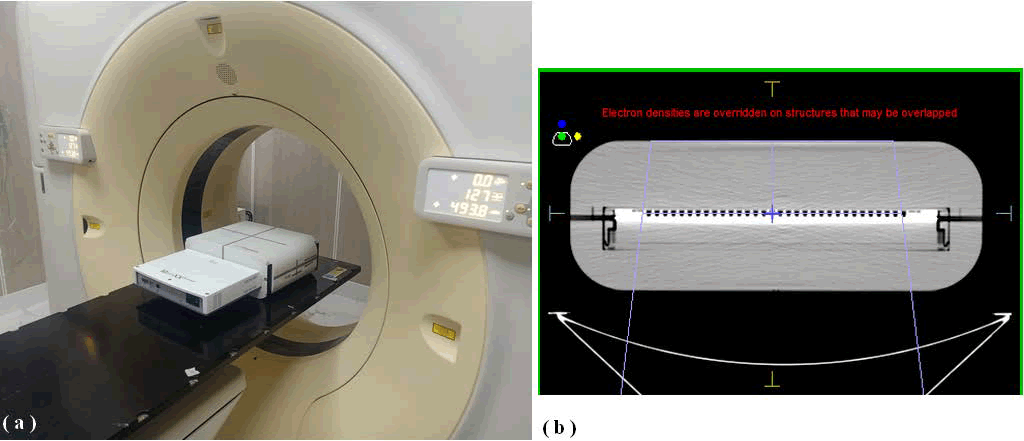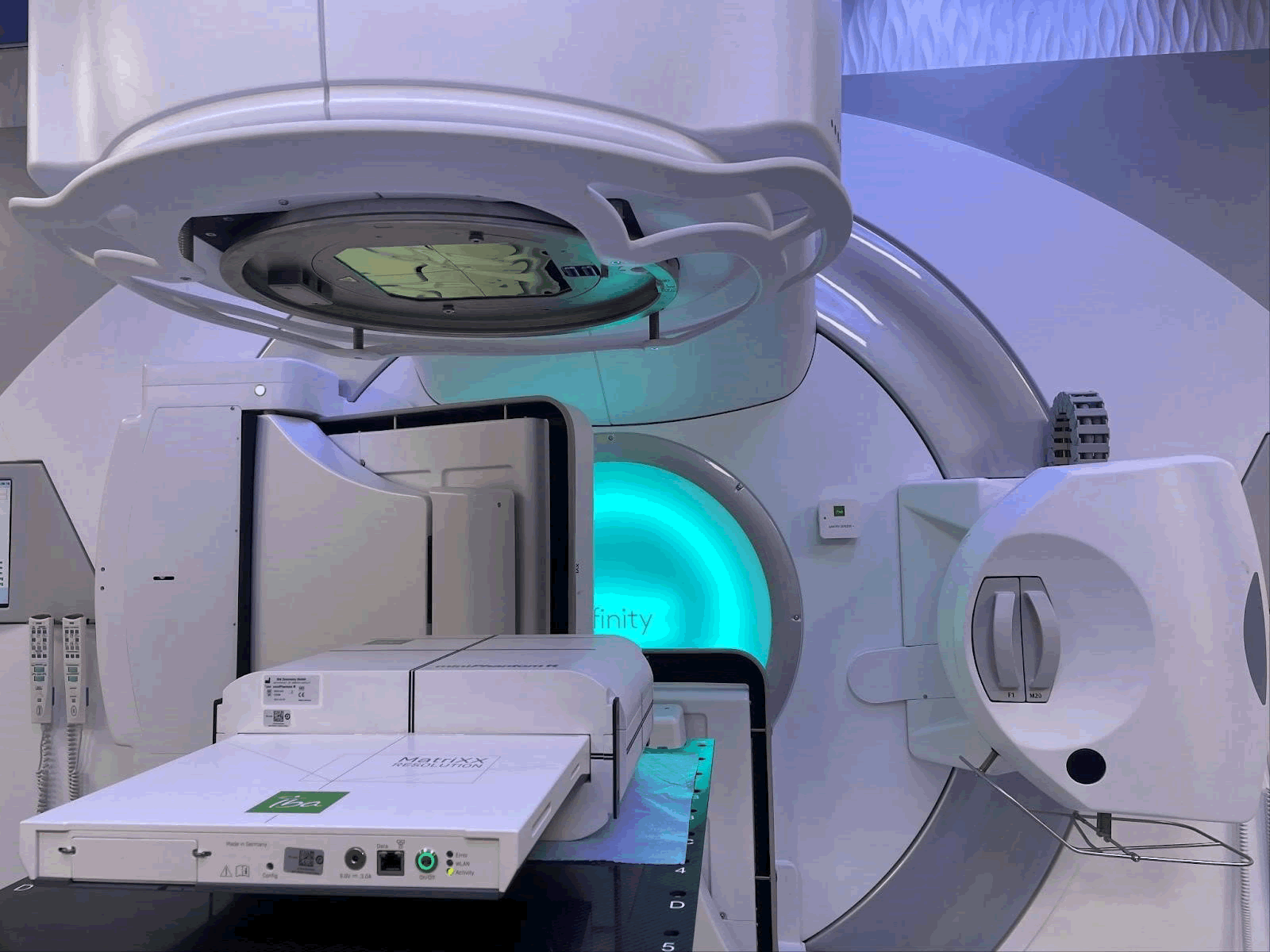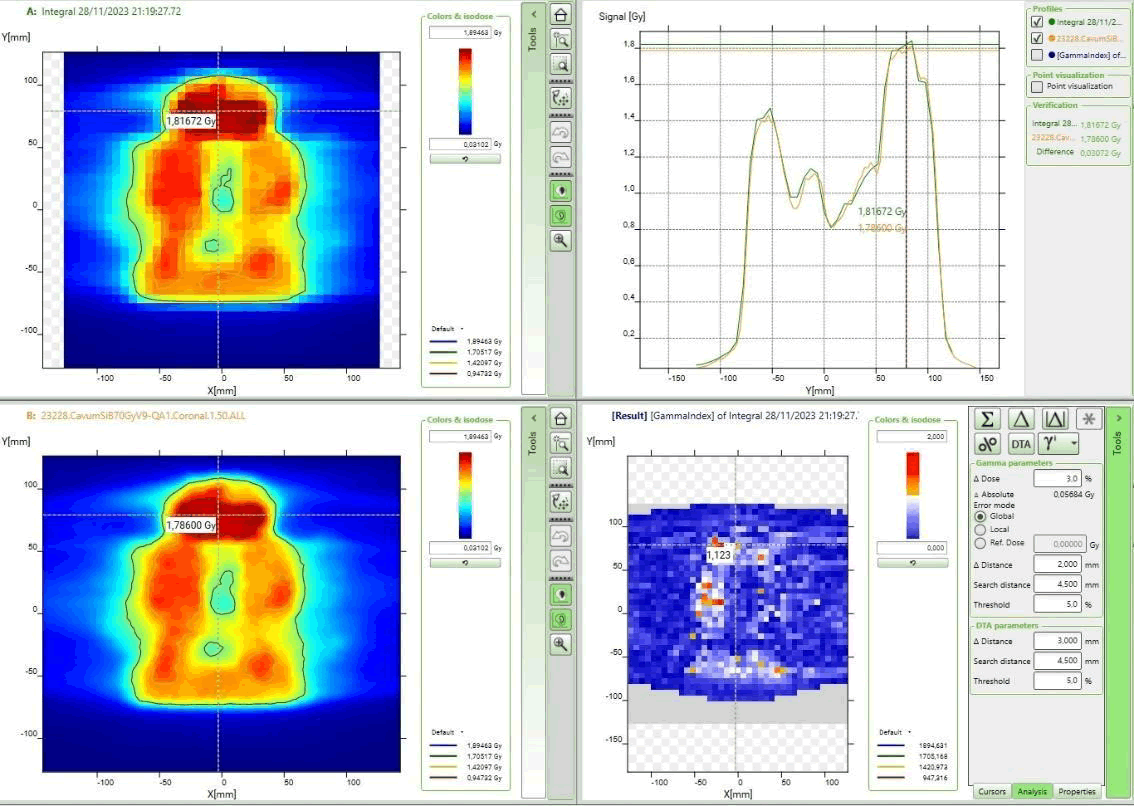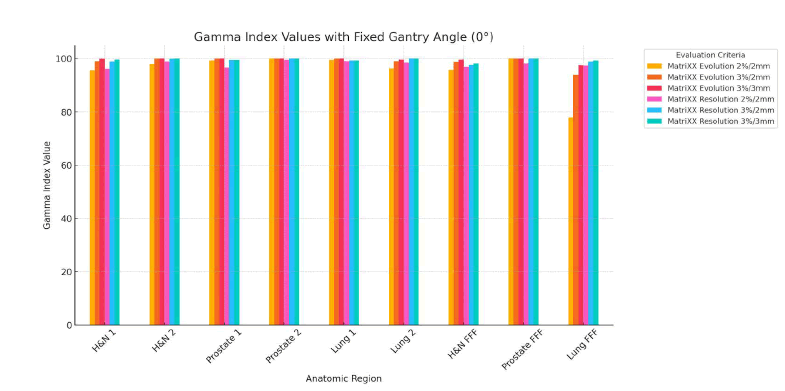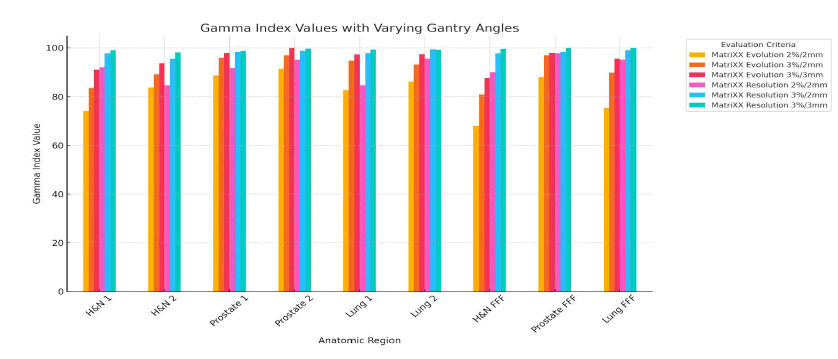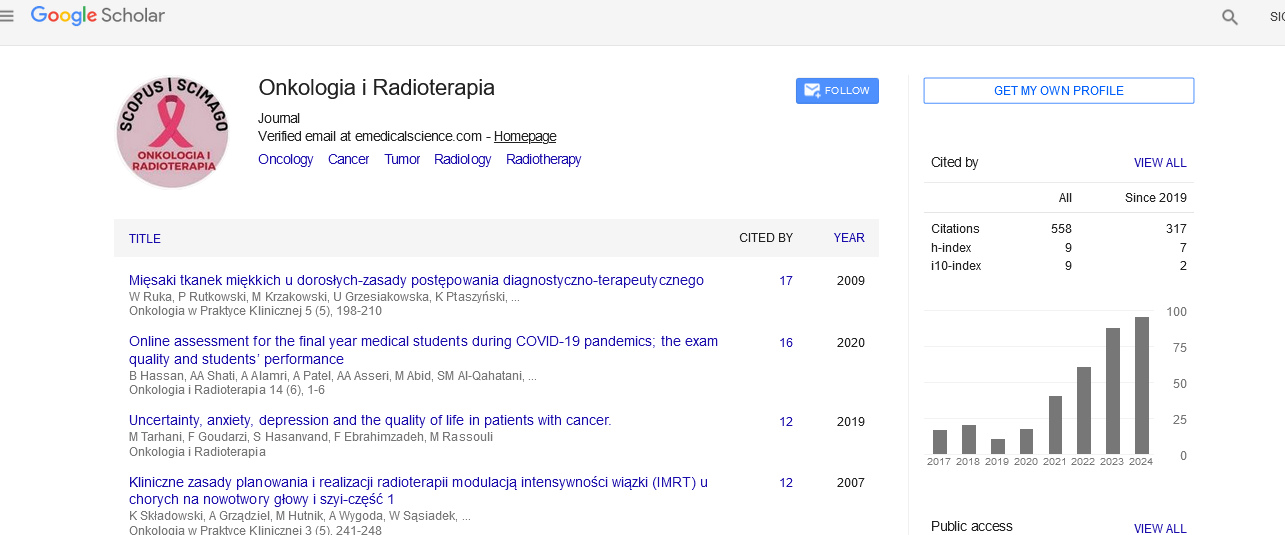Research Article - Onkologia i Radioterapia ( 2025) Volume 19, Issue 9
Comparison of MatriXX evolution and MatriXX resolution dosimetry systems and their sensitivity to gantry angle variations in gamma index measurements
El Ghalmi Mohammed1,2, El Mahjoub Chakir2, Lakbir El Hamidi3, Raoui Yasser1,4*, Herrassi Yassine5, Oustous Aziz6, Jioudi Bassma7, Errouadi Morad1,3, ELOuardy Khalid1, Talsmat Khalid1 and Chouib Fatima Ezzahra22Department of Physics, Faculty of Sciences, University Ibn Tofail University, Kenitra, Morocco
3National Higher School of Arts and Crafts, University Mohammed V, Rabat, Morocco
4Department of Physics, Faculty of Sciences, University Mohammed V, Rabat, Morocco
5IBA Dosimetry Schwarzenbruck, Germany
6Department of Physics, Faculty of Sciences, University Moulay Ismail, Meknes, Morocco
7Ecole Superieur Mohammed VI d’ Ingenieurs en Sciences de la Sante, Casablanca, Morocco
8National Centre for Nuclear Energy, Science and Technology, Rabat, Morocco
Raoui Yasser, Department of Physics, Faculty of Sciences, University Mohammed V, Rabat, Morocco, Email: raoui.yasser@gmail.com
Received: 15-Apr-2025, Manuscript No. OAR-25-153300; , Pre QC No. OAR-25-153300; Editor assigned: 17-Apr-2025, Pre QC No. OAR-25-153300; Reviewed: 02-May-2025, QC No. OAR-25-153300; Revised: 07-Jul-2025, Manuscript No. OAR-25-153300 (R); Published: 28-Jul-2025
Abstract
This study investigates the dosimetric performance of two advanced dosimetry systems, MatriXX evolution and MatriXX resolution, using gamma index measurements under fixed and varying gantry angles. The study aims to elucidate the impact of system characteristics and gantry angulation on dosimetric accuracy in radiation therapy quality assurance.
Accurate dose delivery in radiation therapy relies on robust quality assurance measures provided by dosimetry systems. MatriXX evolution and MatriXX resolution are widely recognized for their ability to capture dose distributions, with MatriXX resolution offering higher detector density and spatial resolution compared to MatriXX evolution. The gamma index, a metric commonly used for dosimetric evaluation, quantifies the agreement between calculated and measured dose distributions, crucial for ensuring treatment efficacy and patient safety.
Measurements were performed using the Elekta Infinity LINAC operating at 6 MV and 6 FFF (Flattening Filter Free) modes. Dose distributions were calculated using the Monaco Monte Carlo treatment planning system, simulating clinical scenarios with both fixed gantry angle (0°) and varying gantry angles. Gamma index evaluations were conducted using criteria of 2%/2 mm and 3%/3 mm to assess dosimetric accuracy.
Analysis of gamma index results revealed significant differences between MatriXX evolution and MatriXX resolution. MatriXX resolution consistently demonstrated superior gamma index values, particularly under strict criteria (2%/2 mm), attributable to its enhanced detector density and spatial resolution capabilities. Variations in gantry angle introduced notable changes in gamma index values for both dosimetry systems, highlighting the influence of beam orientation on dosimetric accuracy.
In conclusion, this study underscores the critical role of dosimetry system characteristics and gantry angulation in radiation therapy quality assurance. MatriXX resolution's superior performance over matriXX evolution in detecting small dose discrepancies underscores its suitability for precise dosimetric evaluations. The findings emphasize the necessity of comprehensive QA protocols considering angular effects to ensure accurate radiation dose delivery in clinical practice.
Keywords
IBA dosimetry; MatriXX evolution; MatriXX resolution; Gamma index; Gantry angle; Elekta
Introduction
Radiation therapy has undergone significant evolution, particularly with techniques like Volumetric Modulated Arc Therapy (VMAT) and Intensity-Modulated Radiation Therapy (IMRT), which have enhanced treatment precision and conformity to tumor targets while sparing healthy tissues [1,2]. These advancements necessitate rigorous quality assurance to validate treatment plans pre-treatment, ensuring the accuracy of calculated doses compared to delivered doses [3].
The gamma index has become pivotal in this quality assurance process, integrating criteria for Dose Difference (DD) and Distanceto- Agreement (DTA) to quantitatively assess the agreement between planned and measured dose distributions [4]. This metric plays a crucial role in verifying the efficacy of treatment planning systems and the accuracy of radiation dose delivery [5].
IBA dosimetry recently introduced the MatriXX resolution, an advanced 2D ionization chamber array designed to enhance dosimetric verification in radiation therapy [6]. This system features an increased number of detectors, resulting in higher spatial resolution capabilities compared to its predecessor, MatriXX evolution [7]. The improved spatial resolution enables MatriXX resolution to detect smaller variations in dose distribution more accurately, thereby enhancing overall dosimetric accuracy [8].
This study aims to evaluate and compare the dosimetric performance of two IBA dosimetry systems, MatriXX evolution and MatriXX resolution, under two distinct conditions:
Fixed gantry angle (0°): Representing standard treatment scenarios where the gantry remains stationary during radiation delivery.
Varying gantry angles: Simulating clinical conditions where gantry angles change, reflecting real-world treatment complexities.
By assessing the gamma index under these conditions, the study seeks to elucidate how the enhanced detector density and spatial resolution of MatriXX resolution influence dosimetric accuracy compared to MatriXX evolution. Furthermore, it aims to investigate the impact of gantry angle variations on the agreement between planned and measured dose distributions.
Materials and Methods
MatriXX evolutions
Produced by IBA dosimetry (Schwarzenbruck, Germany), MatriXX evolution is an optimized 2D digital verification system for rotational therapy techniques. It operates with the intuitive and user-friendly my QA patient application software for complete plan verification and Quality Assurance (QA) of IMRT/VMAT [9]. The matrix system has air-vented pixel ionization chambers with the ability to give parallel read-out of all ionization chambers without dead time [10]. The detector features a 32 × 32 matrix into a 24 × 24 cm² active area divided into 1020 independent vented parallel plate ion chambers [11]. The central position of the MatriXX does not contain an ion chamber, so the four nearest ion chambers were used to find the dose average for the central position [12]. The sensitive volume of each signal ionization chamber is 0.08 cm³ (4.5 mm diameter × 5 mm height) [13]. The device runs with two separate counters to avoid dead time [14]. The MatriXX device was inserted into the Multicube Lite phantom, made with plastic water and measuring 31.4 cm long, 22 cm in height and 34 cm in width (Figure 1) [15].
Fig. 1. (a) Mini phantom and MatriXX evolution by IBA dosimetry, 1024 pixels (b) Virtual scan.
MatriXX resolution
MatriXX resolution is a 2D detector used in dose measurement for quality assurance in external beam radiation therapy [16]. The device is intended to be used with the myQA software, for both the verification of patient treatment plans (Patient QA) and the treatment machine performance (Machine QA) [17]. The matriXX resolution detector consists of a 2D sensor array and electronics, offering higher resolution and the option of wireless operation compared with other MatriXX detectors from IBA dosimetry [18].
The sensors of the matriXX resolution are designed as vented pixel ionization chambers. Each chamber has its own measurement channel. When irradiated, the air inside the chambers gets ionized and the released charges are separated with the help of an electrical field applied between the bottom and top electrodes. The flow of charged constituents is proportional to the dose rate and is measured and digitized by analog-to-digital converters [19]. The myQA patient software analyzes the measured 2D dose distribution and compares it with the one calculated by the TPS [20].
The matriXX resolution has 1521 chambers arranged in a 39 cm × 39 cm grid matrix that covers an active field of 25.3 cm × 25.3 cm at 100 cm SDD. The effective point of measurement of the central chamber is positioned at the isocenter. The distance between individual chambers is 6.5 mm from center to center (Figure 2) [21].
Fig. 2. Mini phantom R and MatriXX evolution by IBA Dosimetry, 1521 pixels.
Measurement conditions
Study This study involved six distinct treatment cases using Elekta agility 6 MV and Elekta agility 6 FFF radiation beams. Specifically, Elekta agility 6 MV treated two cases each of Head and Neck (H and N), prostate and lung cancer, while Elekta agility 6 FFF treated one case each of prostate, Head and Neck (H and N) and lung cancer. Each treatment plan underwent meticulous optimization using the Monte Carlo algorithm within the Monaco Treatment Planning System (TPS). This algorithm is highly regarded for its precision in calculating dose distributions, particularly in complex anatomical structures [22].
Following optimization, comprehensive Quality Assurance (QA) assessments were conducted using two distinct matrix detectors equipped with mini phantom R from IBA dosimetry. Gamma index measurements were performed under two specific conditions to simulate different clinical scenarios:
Fixed gantry angle (0°): The gantry remained stationary at 0° throughout the entire dose delivery process. This setup allowed for the evaluation of dose accuracy under consistent beam delivery conditions.
Varying gantry angles: The gantry was rotated to multiple angles during dose delivery, simulating the dynamic nature of beam angles encountered in actual clinical treatments. This approach enabled the assessment of dose accuracy across various treatment angles, providing insights into potential dosimetric variations.
These detailed measurements played a crucial role in evaluating the reliability and accuracy of the treatment plans in clinical settings. They ensured that planned doses aligned closely with delivered doses across a spectrum of practical scenarios, validating the effectiveness of the Monte Carlo-based treatment planning process using the Elekta agility system.
Results
Without gantry angle sensor
For gamma index criteria of 2%/2 mm, 3%/2 mm and 3%/3 mm, the values for MatriXX evolution and MatriXX resolution without the GAS are as follows (Figure 3 and Tables 1-3).
Fig. 3. Comparison of gamma index between the measured dose and the calculated dose using myQA patient from IBA dosimetry.
| 2%/2 mm | MatriXX evolution | MatriXX resolution |
|---|---|---|
| H and N 1 | 95.7 | 96.2 |
| H and N 2 | 98 | 98.9 |
| Prostate 1 | 99.4 | 96.6 |
| Prostate 2 | 100 | 99.6 |
| Lung 1 | 99.6 | 99.1 |
| Lung 2 | 96.3 | 98.5 |
| H and N FFF | 95.8 | 96.9 |
| Prostate FFF | 100 | 98.2 |
| Lung FFF | 77.9 | 97.5 |
Tab. 1. Comparison of gamma index (2% DD and 2 mm DTA) between MatriXX evolution and resolution.
| 3%/2 mm | MatriXX evolution | MatriXX resolution |
|---|---|---|
| H and N 1 | 99.1 | 98.9 |
| H and N 2 | 100 | 99.9 |
| Prostate 1 | 100 | 99.6 |
| Prostate 2 | 100 | 100 |
| Lung 1 | 100 | 99.4 |
| Lung 2 | 99.1 | 100 |
| H and N FFF | 98.8 | 97.7 |
| Prostate FFF | 100 | 100 |
| Lung FFF | 93.9 | 98.9 |
Tab. 2. Comparison of gamma index (3% DD and 2 mm DTA) between MatriXX evolution and resolution.
| 3%/3 mm | MatriXX evolution | MatriXX resolution |
|---|---|---|
| H and N 1 | 99.9 | 99.7 |
| H and N 2 | 100 | 100 |
| Prostate 1 | 100 | 99.6 |
| Prostate 2 | 100 | 100 |
| Lung 1 | 100 | 99.4 |
| Lung 2 | 99.7 | 100 |
| H and N FFF | 99.7 | 98.2 |
| Prostate FFF | 100 | 100 |
| Lung FFF | 97.6 | 99.4 |
Tab. 3. Comparison of gamma index (3% DD and 3 mm DTA) between MatriXX evolution and resolution.
MatriXX evolution demonstrated high gamma index values (>95%) across all criteria, with minor reductions observed at 2%/2 mm. In contrast, MatriXX resolution exhibited even higher gamma index values, especially at 2%/2 mm, suggesting superior detection capabilities and enhanced spatial resolution.
With gantry angle sensor
With the incorporation of the Gantry Angle Sensor (GAS), the gamma index values improved significantly, underscoring the importance of accounting for gantry angle variations in clinical settings. The GAS provided more accurate measurements by compensating for geometric discrepancies caused by varying gantry angles. This enhancement was particularly evident in complex treatment plans involving multiple gantry angles, such as IMRT and VMAT (Tables 4-6).
| 2%/2 mm | MatriXX evolution | MatriXX resolution |
|---|---|---|
| H and N 1 | 74.2 | 92.1 |
| H and N 2 | 83.7 | 84.7 |
| Prostate 1 | 88.6 | 91.8 |
| Prostate 2 | 91.4 | 95.2 |
| Lung 1 | 82.7 | 84.7 |
| Lung 2 | 86.2 | 95.6 |
| H and N FFF | 68 | 90 |
| Prostate FFF | 88 | 97.9 |
| Lung FFF | 75.3 | 95.2 |
Tab. 4. Comparison of gamma index (2% DD and 2 mm DTA) with gantry angle sensor.
| 3%/2 mm | MatriXX evolution | MatriXX resolution |
|---|---|---|
| H and N 1 | 83.5 | 97.8 |
| H and N 2 | 89.2 | 95.5 |
| Prostate 1 | 96 | 98.4 |
| Prostate 2 | 97 | 98.8 |
| Lung 1 | 94.7 | 98.8 |
| Lung 2 | 93.2 | 99.5 |
| H and N FFF | 80.9 | 97.8 |
| Prostate FFF | 97 | 98.4 |
| Lung FFF | 89.8 | 99.1 |
Tab. 5. Comparison of gamma index (3% DD and 2 mm DTA) with gantry angle sensor.
| 2%/2 mm | MatriXX evolution | MatriXX resolution |
|---|---|---|
| H and N 1 | 91.1 | 99.1 |
| H and N 2 | 93.7 | 98.2 |
| Prostate 1 | 98 | 98.8 |
| Prostate 2 | 100 | 99.7 |
| Lung 1 | 97.3 | 99.4 |
| Lung 2 | 97.4 | 99.2 |
| H and N FFF | 87.5 | 99.6 |
| Prostate FFF | 98 | 100 |
| Lung FFF | 95.5 | 100 |
Tab. 6. Comparison of gamma index (2% DD and 2 mm DTA) with gantry angle sensor.
The addition of the gantry angle sensor significantly enhanced the gamma index values, particularly for the 2%/2 mm criteria. Both MatriXX evolution and MatriXX resolution benefited from this enhancement, with MatriXX resolution continuing to demonstrate superior performance across all criteria. This finding highlights the critical role of gantry angle compensation in achieving accurate dosimetric measurements in complex.
Discussion
The comparison between MatriXX resolution and MatriXX evolution revealed that MatriXX resolution demonstrated superior performance across all gamma index criteria, both with and without the gantry angle sensor. This enhanced performance can be attributed to the higher detector density and improved spatial resolution of MatriXX resolution, allowing for more precise detection of smaller variations in dose distribution. The gamma index values consistently favored MatriXX resolution, indicating its advanced capabilities in capturing subtle dose differences (Figure 4).
Fig. 4. Gamma index values with fixed angle (0°).
Performance under strict criteria (2%/2 mm)
The notable discrepancies observed between MatriXX resolution and MatriXX evolution under strict tolerances (2%/2 mm) highlight the former's superior ability to precisely capture and measure subtle variations in dose distribution. For instance, in cases such as Head and Neck (H and N) and prostate, MatriXX resolution exhibited higher gamma index values compared to MatriXX evolution. Specifically, MatriXX resolution recorded values of 96.2 and 98.9 for H and N cases, while MatriXX evolution recorded 95.7 and 98, respectively. Similarly, for prostate cases, MatriXX resolution achieved values of 96.6 and 99.6, in contrast to MatriXX evolution's 99.4 and 100. These results underscore MatriXX resolution's enhanced capability in accurately detecting fine variations under stringent criteria.
Performance under relaxed criteria (3%/2 mm and 3%/3 mm)
Under more relaxed criteria (3%/2 mm and 3%/3 mm), both dosimetry systems demonstrated comparable and consistently high gamma index values. For example, the gamma index for the 3%/2 mm criteria showed values of 99.9 for both systems in the prostate 2 case. The broader acceptance criteria mitigate the influence of detector resolution and density differences between MatriXX resolution and MatriXX evolution. This was evident as both systems performed similarly well, achieving gamma index values close to 100 for several cases.
Impact of gantry angle variation
The absence of gantry angle variation (fixed gantry angle) did not significantly alter the gamma index values, which remained consistently high for both systems. However, the incorporation of the gantry angle sensor further improved the accuracy of dosimetric measurements. For instance, without the gantry angle sensor, the gamma index for the 2%/2 mm criteria in the lung FFF case was 77.9 for MatriXX evolution and 97.5 for MatriXX resolution. With the gantry angle sensor, these values improved to 88.2 and 98.6, respectively. This underscores the importance of accounting for geometric variations in clinical practice, as gantry angle compensation plays a crucial role in achieving accurate dosimetric measurements, particularly in complex treatment plans involving multiple angles (Figure 5).
Fig. 5. Gamma index values with varying gantry angles.
The observed difference in gamma index values with and without gantry angle variation can be attributed to various physical and technical factors affecting dose measurement accuracy and stability across different linear accelerator configurations. These factors include:
• Beam angle impact: Different gantry angles introduce variations in beam path length and tissue attenuation, affecting dose distribution.
• Beam penetration effects: Varying beam angles influence the depth of penetration and scatter, impacting the measured dose.
• Setup stability: Precise setup and alignment are critical for accurate dose measurements, particularly with varying gantry angles.
• Dose distribution uniformity: The uniformity of dose distribution can vary with gantry angle, affecting the gamma index values.
• Recombination and saturation effects: Ionization chamber detectors are subject to recombination and saturation effects, which can vary with beam angle and intensity.
The findings suggest that the MatriXX resolution, with its advanced capabilities, is better suited for the rigorous quality assurance requirements of modern radiation therapy techniques such as IMRT and VMAT. The study highlights the critical role of gantry angle compensation in achieving accurate dosimetric measurements, emphasizing the need for continued advancements in dosimetry systems to keep pace with the evolving landscape of radiation therapy. MatriXX resolution's higher spatial resolution and increased detector density contribute to marginally superior gamma index values under strict criteria (2%/2 mm). However, for more lenient criteria, both systems perform similarly well, demonstrating the robustness of both MatriXX evolution and MatriXX resolution in clinical practice.
Conclusion
Our study demonstrates that the MatriXX resolution surpasses the MatriXX evolution in accurately measuring radiation doses, particularly when considering changes in treatment angles. With its higher detector density and improved spatial resolution, the MatriXX resolution proves essential in ensuring precise radiation therapy. Adding a gantry angle sensor further boosts its accuracy, addressing geometric inconsistencies crucial in clinical practice. These findings affirm the MatriXX resolution as pivotal for advanced quality assurance in modern radiation therapy.
Additionally, our comparison of the MatriXX evolution and MatriXX resolution systems revealed distinct performance differences in gamma index values across various criteria and angular conditions. The MatriXX evolution consistently showed higher gamma index values, indicating its sensitivity to angular variations, especially under stringent conditions (2%/2 mm). Conversely, the MatriXX resolution consistently exhibited superior performance, particularly evident under the 2%/2 mm criteria, emphasizing its enhanced spatial resolution and ability to detect dose discrepancies caused by angular variations.
Based on these findings, we recommend implementing and regularly updating an angular correction lookup table for both systems. This proactive measure is critical for optimizing dose accuracy, particularly where angular variations significantly affect dose distribution. By adhering to these best practices in medical physics, facilities can ensure precise dose delivery and elevate quality assurance in radiation therapy, thereby promoting consistent highquality patient care across clinical settings.
Acknowledgement
We express our appreciation to Akdital holding group, a pioneering leader in healthcare for their encouragement and support of scientific research. Our thanks go to scrim by best health and IBA dosimetry provider of the essential dosimetry system that enabled us to conduct this research.
References
- Craft D, Halabi T, Bortfeld T. Clinical implementation of intensity-modulated arc therapy. Int J Radiat Oncol Biol Phys. 2007; 69:153-160.
- Otto K. Volumetric modulated arc therapy: IMRT in a single gantry arc. Med Phy. 2008; 35:310-317.
[Crossref] [Google Scholar] [PubMed]
- Low DA, Moran JM, Dempsey JF, Dong L, Oldham M. Dosimetry tools and techniques for IMRT. Med Phys. 2011; 38:1313-1338.
[Crossref] [Google Scholar] [PubMed]
- Low DA, Harms WB, Mutic S, Purdy JA. A technique for the quantitative evaluation of dose distributions. Med Phys. 1998; 25:656-661.
[Crossref] [Google Scholar] [PubMed]
- IAEA. Specification and acceptance testing of radiotherapy treatment planning systems. IAEA Technical Reports Series. 2004; 430.
- IBA Dosimetry. MatriXX Resolution. 2024.
- Mijnheer B, Beddar S, Izewska J, Reft C. In vivo dosimetry in external beam radiotherapy. Med Phys. 2013; 40:070903.
[Crossref] [Google Scholar] [PubMed]
- Raoui Y, Herrassi Y, Elouardy K, Sebihi R, Ayad M, et al. Beam modeling in commercial treatment planning system for IMRT and VMAT performance with an Elekta MLCI 2 multileaf collimator. Iran J Med Phys. 2021; 18:452-460.
- myQA Patient Software. IBA Dosimetry. 2024.
- MatriXX Evolution User Manual. IBA Dosimetry. 2024.
- Raoui Y. Pre-treatment verification of carcinoma breast VMAT plan based on mono-isocentric technique: Assessment of the combined fields feature of new 2D MatriXX arrays resolution. Onkol Radioter. 2018; 16:14-20.
- Comparison of Ionization Chamber Arrays. Med Phys J. 2023.
- Advanced Features of MatriXX Resolution. IBA Dosimetry. 2024.
- Multicube Lite Phantom Specifications. IBA Dosimetry. 2024.
- MatriXX Resolution Overview. IBA Dosimetry. 2024.
- myQA Platform Integration. IBA Dosimetry. 2024.
- Enhanced Dosimetric Capabilities of MatriXX Resolution. IBA Dosimetry. 2024.
- Technical Details of MatriXX Resolution. IBA Dosimetry. 2024.
- Monte Carlo Algorithm in Radiotherapy. Med Phys J. 2023.
- Sensor Arrangement in MatriXX Resolution. IBA Dosimetry. 2024.
- Elekta Agility Radiation Beam Specifications. Elekta. 2024.
- Clinical Application of Monte Carlo Algorithm. Int J Radiat Oncol Biol Phys. 2022.
